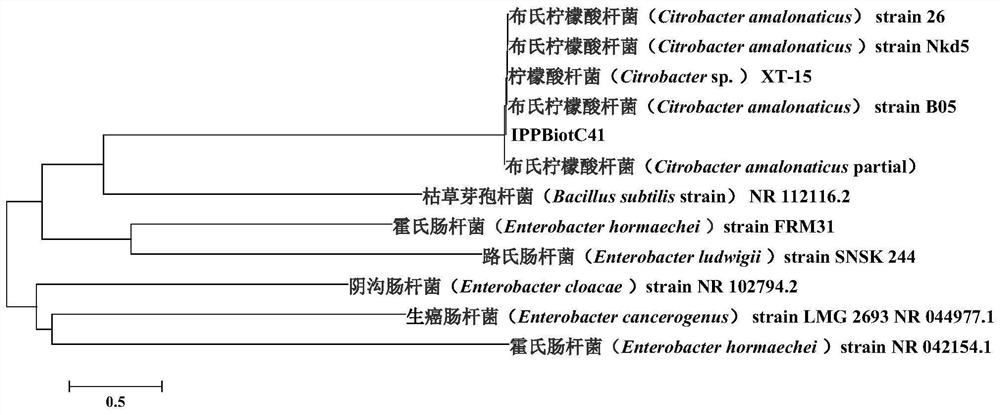A kind of citric acid bacteria and its application in controlling scarab
A technology of citric acid bacteria and scarab, which is applied in the field of control of scarab, can solve the problem that the beneficial function of citric acid bacteria needs to be developed, and achieve the effect of benefiting resistance management and broadening the use
- Summary
- Abstract
- Description
- Claims
- Application Information
AI Technical Summary
Problems solved by technology
Method used
Image
Examples
Embodiment 1
[0024] Isolation and taxonomic identification of strains
[0025] 1.1 Field peanut planting and grub inoculation
[0026] In the experimental field of Langfang Experimental Base, Hebei Province, 1 mu of land was selected to plant peanuts, and five points were selected to bury 304 stainless steel cages in the field before sowing to limit the spread of subsequent inoculated grubs to the surrounding area. When sowing, sow 3 peanut seeds in each hole and water every 3 days. Inoculate the third-instar diablo larvae that have been starved for 48 hours at the peanut pod stage, 15 per cage, and take samples 7 days after the inoculation of diablo larvae, and collect peanut rhizosphere soil repeatedly at 3 points in each cage .
[0027] 1.2 Field rhizosphere soil collection and processing
[0028] The rhizosphere soil of peanuts was collected and processed as follows:
[0029] Take out the peanut root system completely, shake off the non-rhizosphere soil on the peanut root, leaving ...
Embodiment 2
[0034] Bioactivity Analysis
[0035] (1) Determination of the biological activity of the larvae of the black gill beetle
[0036] Inoculate the single clone numbered IPPBiotC41 in a test tube containing 5 mL of liquid LB medium (tryptone 10.0 g / L, yeast extract 5.0 g / L, NaCl 10.0 g / L, sterilized at 121°C for 20 min), and inoculate at 30 Cultivate at ℃ for 12 hours for activation, then transfer the activated bacterial solution to solid LB medium (LB liquid medium plus agar 15g / L, culture dish diameter 15cm), cultivate at 30℃ for 12 hours, and use a sterile scraper Collect the cells with a shovel, suspend the cells evenly with PBS buffer, and count the suspended cells on plates. The counted cells were sonicated (Ampl 70%, pulsed for 3 s, paused for 5 s), so that the total protein was released from the cells, and the crushed cell liquid was obtained.
[0037] Prepare carrot shreds, rinse the carrot shreds with clear water, and let the carrot shreds dry until there is no moistur...
Embodiment 3
[0064] Identification of IPPBiotC41 strain
[0065] IPPBiotC41 genomic DNA was extracted with reference to the method described for extracting Gram-negative bacteria in molecular cloning. The 16S rDNA sequence of IPPBiotC41 was amplified with bacterial 16S rDNA universal primers: 27F (as shown in SEQ ID No. 1) and 1492R (as shown in SEQ ID No. 2), and a multi-fragment of about 1.4 kb was obtained. Purified by the kit for TA cloning, and the clone obtained by transforming Escherichia coli was sent to Sangon Bioengineering (Shanghai) Co., Ltd. for sequencing after being verified by bacterial liquid PCR. The obtained sequence was 1404bp (as shown in SEQ ID No.3) . The measured sequences were submitted to the EzBioCloud website for homology comparison, and a phylogenetic tree was constructed using MEGA6.0 ( figure 1 ). according to figure 1 It can be seen from the phylogenetic tree that it is closely related to the strain of Citrobacter brackeni of the genus Citrobacter. There...
PUM
| Property | Measurement | Unit |
|---|---|---|
| diameter | aaaaa | aaaaa |
Abstract
Description
Claims
Application Information
 Login to View More
Login to View More - R&D
- Intellectual Property
- Life Sciences
- Materials
- Tech Scout
- Unparalleled Data Quality
- Higher Quality Content
- 60% Fewer Hallucinations
Browse by: Latest US Patents, China's latest patents, Technical Efficacy Thesaurus, Application Domain, Technology Topic, Popular Technical Reports.
© 2025 PatSnap. All rights reserved.Legal|Privacy policy|Modern Slavery Act Transparency Statement|Sitemap|About US| Contact US: help@patsnap.com



